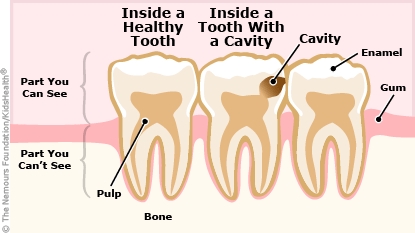Dental Cavity: How to Care for Your Child
A cavity is a hole in a tooth that can grow bigger and deeper over time. Dentists treat most cavities in kids by drilling a small hole in the tooth and then putting a "filling" into the hole. The dentist numbs the area first, so it is usually a painless procedure. Here's how to care for your child and help prevent new cavities.


After a filling for a cavity, ask your dentist:
-
How long your child's mouth will be numb. Watch that your child does not bite the lip or tongue while still numb.
-
How long your child needs to wait before eating or drinking.
-
If your child needs to avoid things that can cause sensitivity (tooth pain when biting down hard or eating or drinking something hot, cold, or sweet).
To help prevent cavities:
-
Brushing and Flossing
-
For children under 3 years old: Help your child brush twice a day for 2 minutes with a soft toothbrush with a smear (the size of a grain of rice) of fluoride toothpaste.
-
For children 3 years old and older: Help your child brush twice a day for 2 minutes with a pea-size amount of fluoride toothpaste. Teach your child to spit the toothpaste out. When your child has teeth that touch, help them floss once a day.
-
Children 10 years and older usually can brush and floss on their own. Help them remember to brush twice a day and floss once a day.
-
Other Reminders
-
Follow your dentist's instructions about fluoride supplements, treatments, and mouthwash.
-
By 1 year of age, your child should be off the bottle and using a cup instead.
-
Do not give juice to babies younger than 12 months old. If you decide to give juice after that, give less than 4 ounces a day to toddlers, less than 6 ounces a day to kids ages 4–6, and less than 8 ounces to kids over age 7. Always use 100% fruit juice, serve it in a cup (not in a bottle), and give it at mealtimes only.
-
Don't let your child go to bed with a bottle or sippy cup with milk or juice in it. Don't let them sip on a bottle or sippy cup throughout the day with anything but water in it.
-
Limit sugar-sweetened beverages (like soda, juice drinks, sports drinks, and flavored milks) and sugary snacks (especially sticky candy). If your child does have these, serve at mealtimes, and have them brush their teeth after.

Your child:
-
has new or increased tooth pain
-
has a new filling that is sensitive for longer than 2–4 weeks
-
has signs of infection, such as redness or swelling around the tooth, jaw, face, or neck

How do cavities happen? Cavities happen when bacteria (germs) and food left on the teeth after eating are not brushed or flossed away. The bacteria make acid that softens the tooth's outer hard surface (called the enamel). When this happens, the acids can cause decay (breakdown) deeper in the tooth. This can lead to a cavity forming that sometimes causes tooth pain or sensitivity.
How often should my child see the dentist? Most kids should go to the dentist every 6 months for a cleaning and checkup. Some kids need to go more often if they are getting a lot of cavities or having other problems with their teeth.